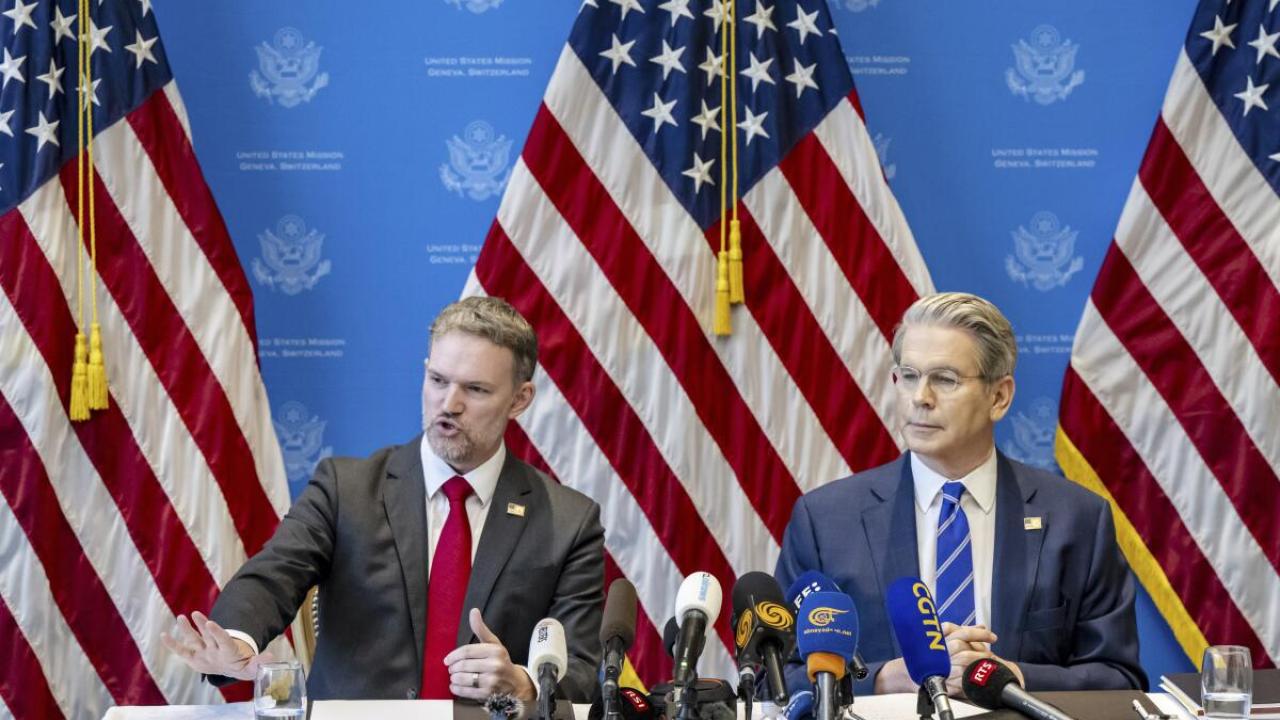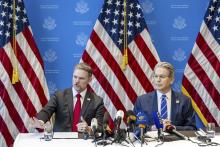
Faced with the reality of 10% tariffs imposed on economies like Peru and Chile, bilateral negotiations and economic diversification appear to prevail over open confrontation.
On Monday, the 12th, the United States and China decided to ease tensions in the trade war they have been waging since the start of the Donald Trump administration. Both powers agreed to cut import taxes on each other's products for 90 days, starting this Wednesday, which will allow negotiations to continue during this period.
This was announced by US Trade Representative Jamieson Greer and Treasury Secretary Scott Bressent. Specifically, Washington will reduce its tariffs on Chinese products from up to 145% to 30%. China, for its part, will reduce its tariffs on US imports from 125% to 10%.
This is a respite that comes after negotiations held in Switzerland last weekend on reciprocal tariffs, which Washington intended to impose to alleviate its trade imbalance.
But the immediate effect was that Beijing retaliated by imposing 34% tariffs on the United States in early April. This marked the beginning of tense negotiations that ultimately led to Trump's decision to grant China a tariff pause, a measure he had taken with the rest of the economies affected by his protectionism.
It's worth noting that the US announcement had a knock-on effect on financial markets battered by the trade war. For example, S&P 500 futures rose nearly 3% early Monday, and the Nasdaq, a technology-focused index, soared nearly 4%. At the same time, the dollar gained ground against the euro and the yen, contributing to inflation falling below expectations for two consecutive months now.
However, according to Mauricio Guzmán, head of Investment Strategy at SURA Investments , the recent high volatility, the latent risk of ongoing trade negotiations, and the possibility that inflation could experience upward pressures due to the pending transmission of tariffs still in effect, lead to cautious forecasts regarding risk.
"Additionally, given the high level of real rates and the fact that the inflation normalization process continues, opening the door to the possibility of the Fed resuming its cuts, we maintain our preference for duration, which in turn provides protection against new risk events," Guzmán stated.
SIDE EFFECTS IN LATIN AMERICA
Following the imposition of 10% tariffs on exports from many Latin American economies, China has sought to strengthen its trade ties with the region. In addition to Brazilian President Lula da Silva's recent visit to Beijing to boost grain and meat exports, China is hosting a key event.
This is the 4th Ministerial Meeting between the Community of Latin American and Caribbean States (CELAC) and the Chinese government. In addition to Lula, the meeting will include Presidents Gabriel Boric (Chile), Gustavo Petro (Colombia), and host Xi Jinping, who will deliver a keynote address for the first time in 10 years.
THE ROLE OF PERU
This growing interest has raised alarm bells in the United States. As an example, the Department of Defense recently warned Peru to limit China's influence on its territory with initiatives such as the Chancay Megaport and investments in the electricity system.
"Beijing invests and operates in the region to obtain unfair economic benefits," U.S. Defense Secretary Pete Hegseth said during a meeting at the Pentagon with Elmer Schialer and Walter Astudillo, Peru's foreign and defense ministers, respectively.
Meanwhile, the 10% tariff levy on the Andean country remains in effect, raising concerns among experts about its effects. A report by the investment bank Renta 4 states that although the trade war poses downside risks to Peruvian GDP growth in 2025, its impact would be limited. However, in 2026, an election year with less investment momentum, the global economic slowdown would take a greater toll on the national economy.
Now, it's worth asking how justifiable Trump's tariffs have been. For Gonzalo Bernal, a lawyer specializing in international law and economics at Estudio Echecopar (Peru), the United States did not apply any exception clause in its Free Trade Agreements (FTAs) to impose reciprocal tariffs. Peru is no exception.
"If we analyze the 2009 trade agreement, there is a chapter that talks about exceptions, and one of the clauses includes the term "national emergency." This is debatable because the goal of Trump's policies is to combat the trade deficits he has with other countries. To what extent can this trade deficit with Peru be considered a national emergency?" Bernal told AméricaEconomía .
For the lawyer, this point would be debated if the Andean country decides to pursue a multilateral dispute with the United States through a lawsuit before the World Trade Organization (WTO), like the one China filed last month. However, Bernal believes this is not advisable, given the political and economic costs that a small country like Peru would entail in a direct confrontation with the North American giant.
"The bilateral agreement with the United States provides that if we believe they violate the FTA, there is an entire dispute resolution chapter. It includes arbitration, which has a set timeframe that could last two or three years. But there are no containment measures regarding tariffs. So the best path is negotiation between governments," Bernal adds.
THE OPPORTUNITY FOR CHILE
On the other hand, while the spokesperson believes the tariffs are not fatal to the Peruvian economy, agricultural exports would be affected by the rising prices of goods such as avocados and blueberries in the US market. A similar situation is being experienced by Chile, its southern neighbor, which also bases its economy on raw materials.
For Bárbara Silva, an international disruptive innovation advisor and CEO of Singularity Chile, the southern country's greatest opportunity to diversify its economic matrix lies in integrating technology into the growth process of the primary sector.
“Chile is a leader in fruit and aquaculture exports, as well as in mining. But it would be even better if we led the orchestration of the food, vegetable, and fruit market from here through the use of technologies like artificial intelligence to create new, more sophisticated export markets that acquire large volumes, like those in India or Europe,” Silva told AméricaEconomía .
In other words, Silva believes that the great mistake many economies face is approaching the tariff conflict out of fear, rather than creativity and innovation. It's worth asking how to stop "solving 21st-century problems with 20th-century tools." For the specialist, the Nordic countries are a clear example.
"We're talking about economies with no more than five million inhabitants, but their competition is not so much in commodities as in the talent they develop and export globally," added Silva, who will lead Singularity Summit Chile, one of the most important exponential programs in Latin America, from June 3 to 4 in Santiago.









